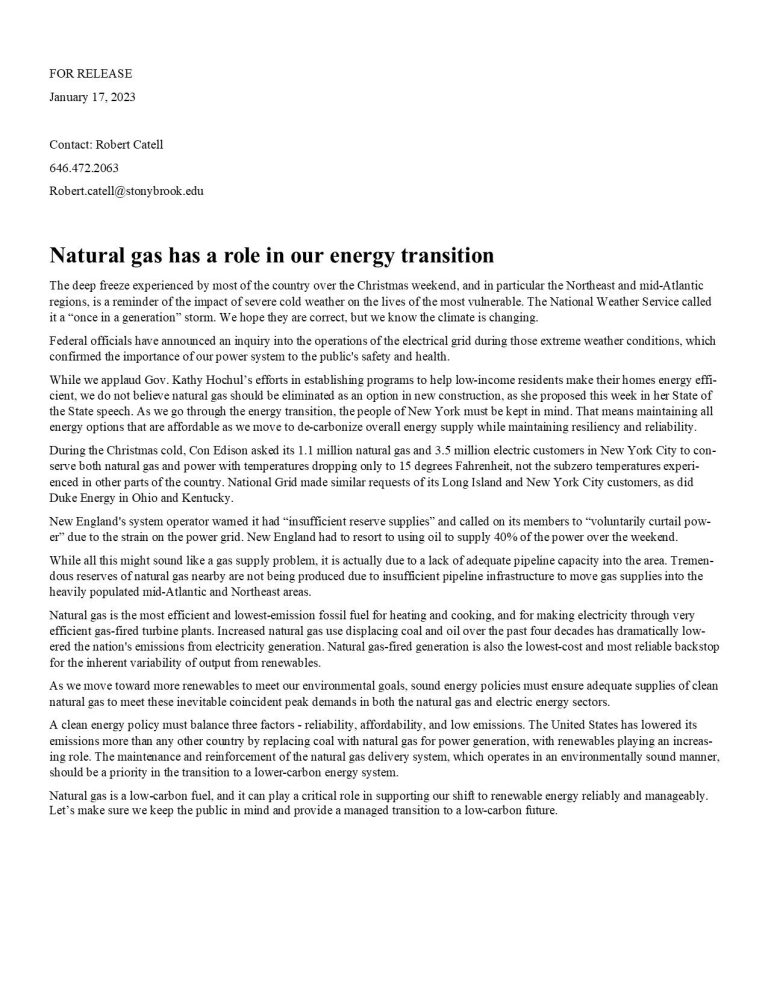
The deep freeze experienced by most of the country over the Christmas weekend, and in particular the Northeast and mid-Atlantic regions, is a reminder of the impact of severe cold weather on the lives of the most vulnerable. The National Weather Service called it a “once in a generation” storm. We hope they are correct, but we know the climate is changing.
Federal officials have announced an inquiry into the operations of the electrical grid during those extreme weather conditions, which confirmed the importance of our power system to the public’s safety and health.
While we applaud Gov. Kathy Hochul’s efforts in establishing programs to help low-income residents make their homes energy efficient, we do not believe natural gas should be eliminated as an option in new construction as she proposed this week in her State of the State speech. As we go through the energy transition, the people of New York must be kept in mind. That means maintaining all energy options that are affordable as we move to de-carbonize the overall energy supply while maintaining resiliency and reliability.
During the Christmas cold, Con Edison asked its 1.1 million natural gas and 3.5 million electric customers in New York City to conserve both natural gas and power with temperatures dropping only to 15 degrees Fahrenheit, not the subzero temperatures experienced in other parts of the country. National Grid made similar requests of its Long Island and New York City customers, as did Duke Energy in Ohio and Kentucky.
New England’s system operator warned it had “insufficient reserve supplies” and called on its members to “voluntarily curtail power” due to the strain on the power grid. New England had to resort to using oil to supply 40% of the power over the weekend.
While all this might sound like a gas supply problem, it is actually due to a lack of adequate pipeline capacity into the area. Tremendous reserves of natural gas nearby are not being produced due to insufficient pipeline infrastructure to move gas supplies into the heavily populated Mid-Atlantic and Northeast areas.
Natural gas is the most efficient and lowest-emission fossil fuel for heating and cooking, and for making electricity through very efficient gas-fired turbine plants. Increased natural gas use displacing coal and oil over the past four decades has dramatically lowered the nation’s emissions from electricity generation. Natural gas-fired generation is also the lowest-cost and most reliable backstop for the inherent variability of output from renewables.
As we move toward more renewables to meet our environmental goals, sound energy policies must ensure adequate supplies of clean natural gas to meet these inevitable coincident peak demands in both the natural gas and electric energy sectors.
A clean energy policy must balance three factors – reliability, affordability, and low emissions. The United States has lowered its emissions more than any other country by replacing coal with natural gas for power generation, with renewables playing an increasing role. The maintenance and reinforcement of the natural gas delivery system, which operates in an environmentally sound manner, should be a priority in the transition to a lower-carbon energy system.
Natural gas is a low-carbon fuel, and it can play a critical role in supporting our shift to renewable energy reliably and manageably. Let’s make sure we keep the public in mind and provide a managed transition to a low-carbon future.
Robert Catell
Garden City
Chairman, chief executive of Keyspan Corp.






